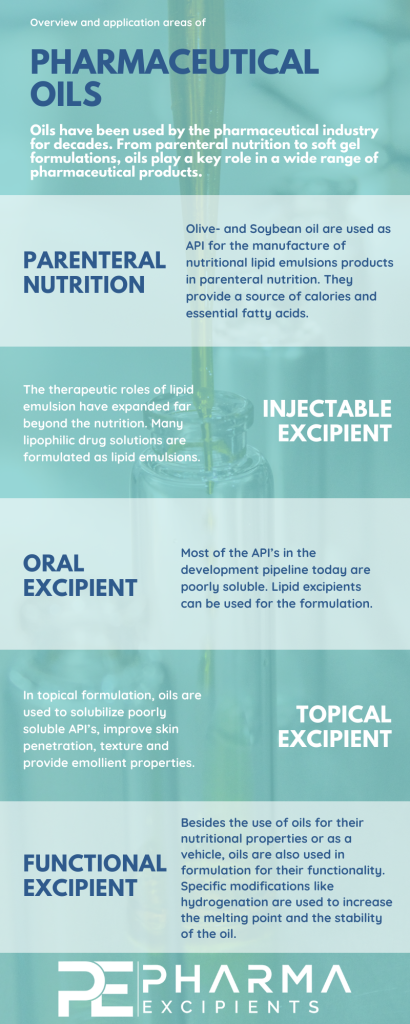Pharmaceutical Oils
Oils have been used by the pharmaceutical industry for decades. From parenteral nutrition to soft gel formulations, oils play a key role in a wide range of pharmaceutical products. With an ever increasing number of new drug candidates with poor aqueous solubility and poor oral bioavailability, oils are very attractive candidates to solve real challenges for the formulators.
Listen to the article:
Parenteral Nutrition: When pharmaceutical oils are considered as an API
Olive oil and soybean oil are used as API for the manufacture of nutritional lipid emulsions products in parenteral nutrition. They provide a source of calories and essential fatty acids for patients who are not able to feed themselves. For parenteral nutrition oils are considered as API and manufactured under cGMP according to the ICH-Q7 Good Manufacturing Practice Guidance for Active Pharmaceutical Ingredients.
Injectable Excipients: From emulsions to depot formulations
The therapeutic roles of lipid emulsions have expanded far beyond the nutrition. Many lipophilic drug solutions are formulated as lipid emulsions, including propofol. Propofol is an intravenous (IV) sedative-hypnotic agent that can be used for initiation and maintenance of Monitored Anesthesia Care (MAC) sedation. Soybean Oil is used as excipient.
Another example of the use of injectable grade oil in the pharmaceutical industry is in depot formulations. Depot formulations (IM) are suitable to avoid first-pass metabolism or for drugs with low oral bioavailability. The API’s are dissolved in oils (sesame oil) for extend release (IM injection) and long-term stability. Hormones (testosterone, progesterone) or antipsychotics drugs (Haloperidol or Fluphenazine) are good example of injectable formulations with sesame oil.

Oral and Topical Excipients: For Vitamin D and CBD oils the preferred choice
Most of the API’s in the development pipeline today are poorly water soluble. Simple formulation approaches are not enough to address these issues. Lipid excipients can be used for the formulation. On the last FDA approved lipid formulations, the majority are soft gel capsules, hard shell capsules and oral solutions.
Vitamin D & other liposoluble vitamins, cannabinoids (CBD) and isotretinoin are very good examples of oral formulations using oils : sesame oil, olive oil, soybean Oil.
In topical formulations, oils are used to solubilize poorly soluble API’s, improve skin penetration, texture and provide emollient properties. Enoxolon and Retinol are good example of topical formulations with olive oil.
Functional excipient: Controlled released with pharmaceutical hydrogenated oils
Besides the use of oils for their nutritional properties or as a vehicle, oils are also used in formulation for their functionality. Specific modifications like hydrogenation are used to increase the melting point and the stability of the oil.
Hydrogenated soybean oils are used in encapsulation processes for the protection and stabilization of the active ingredient but also in controlled release formulations to refine the kinetics of the release profile.
This is “oil” you need …
Oils are still considered today as solutions of choice when it comes to formulating poorly soluble active ingredients or when considering new formulations to increase bioavailability.
More information and samples on ADM-SIO Oils on:
- Hydrogenated Soybean Oil
- Refined Soybean Oil IV
- Refined Olive Oil IV
- ADM-SIO’s Refined Sesame Oil IV-1
Post for pharmaexcipients.com – Prepared by ADM


